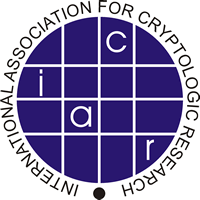eprint.iacr.org/2013/845
Preview meta tags from the eprint.iacr.org website.
Linked Hostnames
6- 21 links toeprint.iacr.org
- 1 link tocreativecommons.org
- 1 link todoi.org
- 1 link toia.cr
- 1 link toiacr.org
- 1 link towww.iacr.org
Thumbnail

Search Engine Appearance
How to Keep a Secret: Leakage Deterring Public-key Cryptography
How is it possible to prevent the sharing of cryptographic functions? This question appears to be fundamentally hard to address since in this setting the owner of the key {\em is} the adversary: she wishes to share a program or device that (potentially only partly) implements her main cryptographic functionality. Given that she possesses the cryptographic key, it is impossible for her to be {\em prevented} from writing code or building a device that uses that key. She may though be {\em deterred} from doing so. We introduce {\em leakage-deterring} public-key cryptographic primitives to address this problem. Such primitives have the feature of enabling the embedding of owner-specific private data into the owner's public-key so that given access to {\em any} (even partially functional) implementation of the primitive, the recovery of the data can be facilitated. We formalize the notion of leakage-deterring in the context of encryption, signature, and identification and we provide efficient generic constructions that facilitate the recoverability of the hidden data while retaining privacy as long as no sharing takes place.
Bing
How to Keep a Secret: Leakage Deterring Public-key Cryptography
How is it possible to prevent the sharing of cryptographic functions? This question appears to be fundamentally hard to address since in this setting the owner of the key {\em is} the adversary: she wishes to share a program or device that (potentially only partly) implements her main cryptographic functionality. Given that she possesses the cryptographic key, it is impossible for her to be {\em prevented} from writing code or building a device that uses that key. She may though be {\em deterred} from doing so. We introduce {\em leakage-deterring} public-key cryptographic primitives to address this problem. Such primitives have the feature of enabling the embedding of owner-specific private data into the owner's public-key so that given access to {\em any} (even partially functional) implementation of the primitive, the recovery of the data can be facilitated. We formalize the notion of leakage-deterring in the context of encryption, signature, and identification and we provide efficient generic constructions that facilitate the recoverability of the hidden data while retaining privacy as long as no sharing takes place.
DuckDuckGo
How to Keep a Secret: Leakage Deterring Public-key Cryptography
How is it possible to prevent the sharing of cryptographic functions? This question appears to be fundamentally hard to address since in this setting the owner of the key {\em is} the adversary: she wishes to share a program or device that (potentially only partly) implements her main cryptographic functionality. Given that she possesses the cryptographic key, it is impossible for her to be {\em prevented} from writing code or building a device that uses that key. She may though be {\em deterred} from doing so. We introduce {\em leakage-deterring} public-key cryptographic primitives to address this problem. Such primitives have the feature of enabling the embedding of owner-specific private data into the owner's public-key so that given access to {\em any} (even partially functional) implementation of the primitive, the recovery of the data can be facilitated. We formalize the notion of leakage-deterring in the context of encryption, signature, and identification and we provide efficient generic constructions that facilitate the recoverability of the hidden data while retaining privacy as long as no sharing takes place.
General Meta Tags
12- titleHow to Keep a Secret: Leakage Deterring Public-key Cryptography
- charsetutf-8
- viewportwidth=device-width, initial-scale=1, shrink-to-fit=no
- citation_titleHow to Keep a Secret: Leakage Deterring Public-key Cryptography
- citation_authorAggelos Kiayias
Open Graph Meta Tags
7- og:imagehttps://eprint.iacr.org/img/iacrlogo.png
- og:image:altIACR logo
- og:urlhttps://eprint.iacr.org/2013/845
- og:site_nameIACR Cryptology ePrint Archive
- og:typearticle
Link Tags
4- apple-touch-icon/img/apple-touch-icon-180x180.png
- shortcut icon/favicon.ico
- stylesheet/css/dist/css/bootstrap.min.css
- stylesheet/css/eprint.css?v=10
Links
26- https://creativecommons.org/licenses/by/4.0
- https://doi.org/10.1145/2508859.2516691
- https://eprint.iacr.org
- https://eprint.iacr.org/2013/845.pdf
- https://eprint.iacr.org/about.html